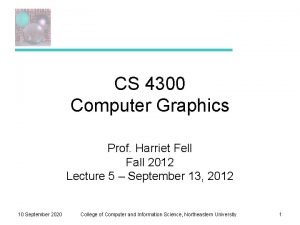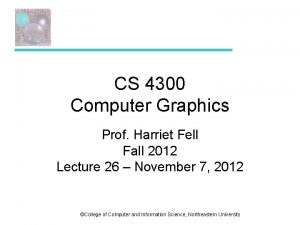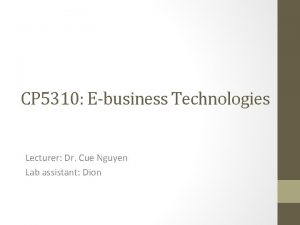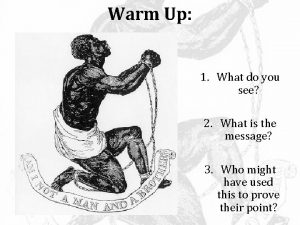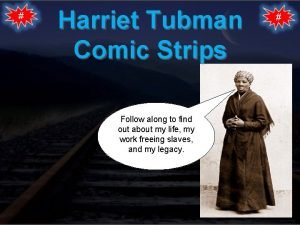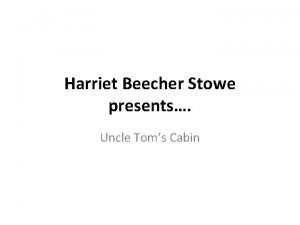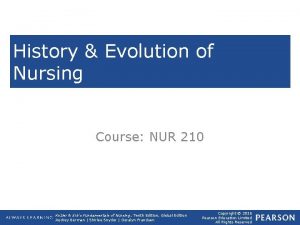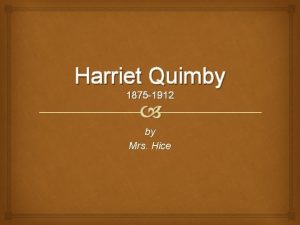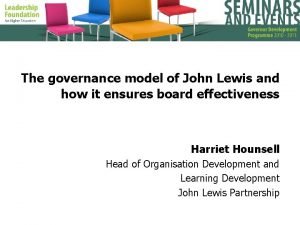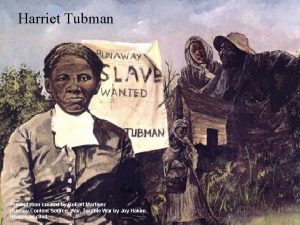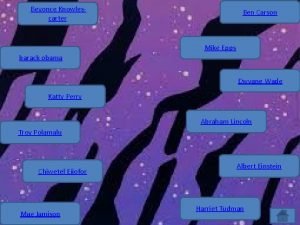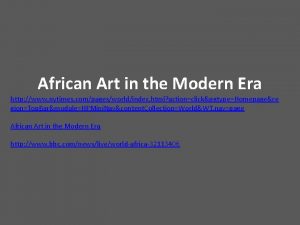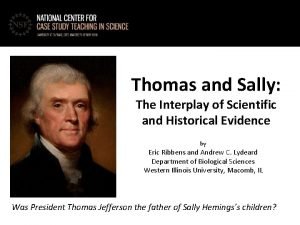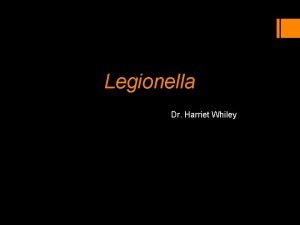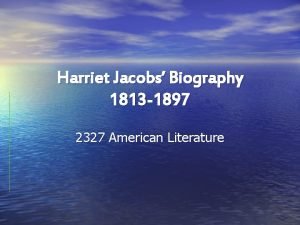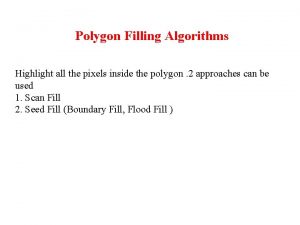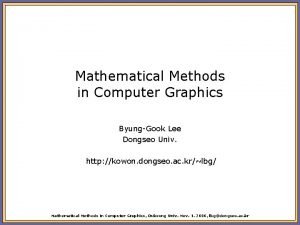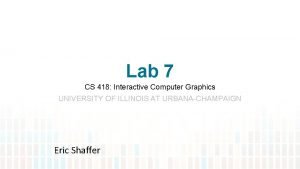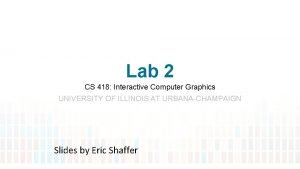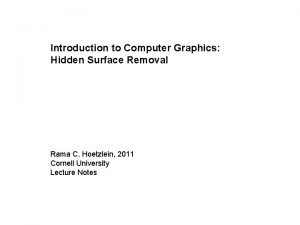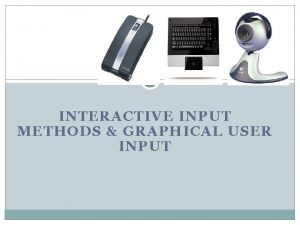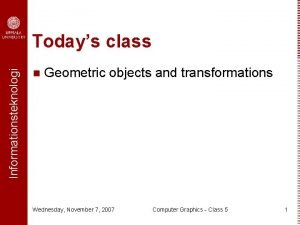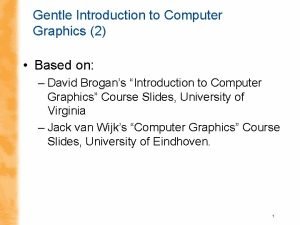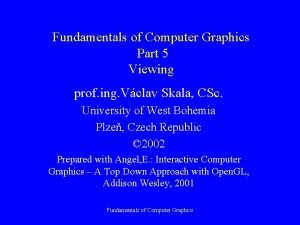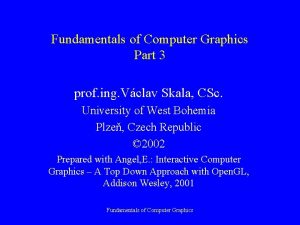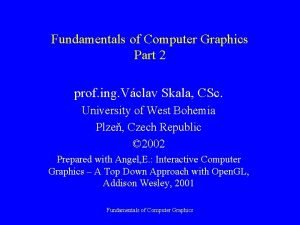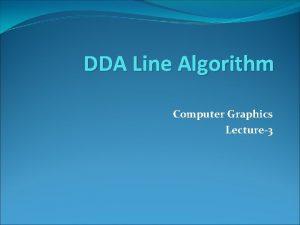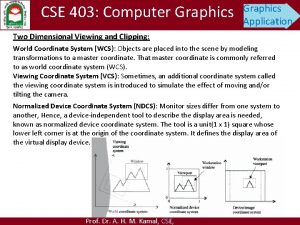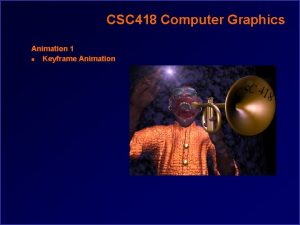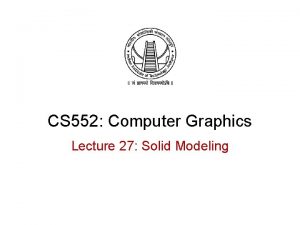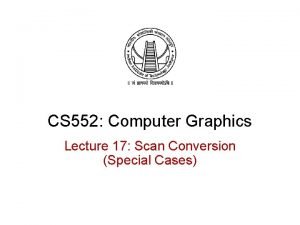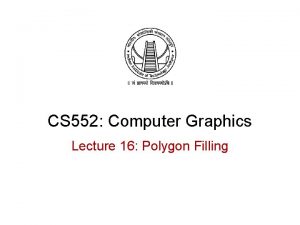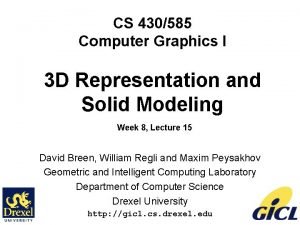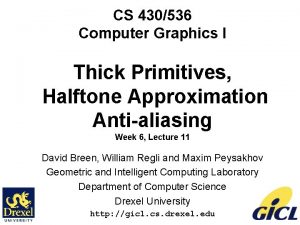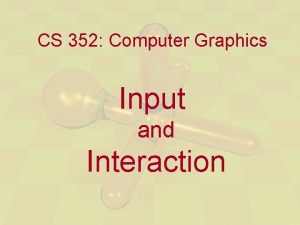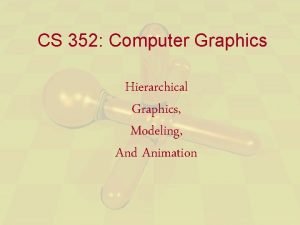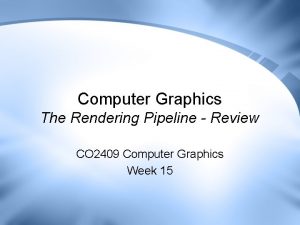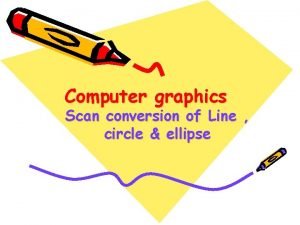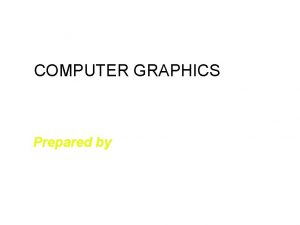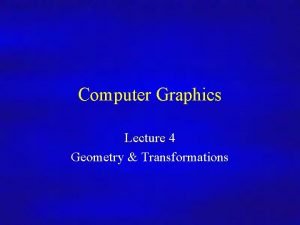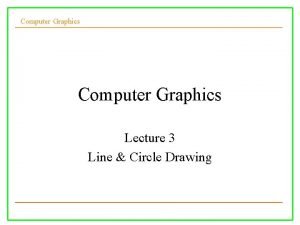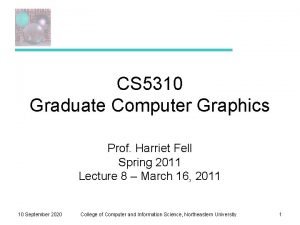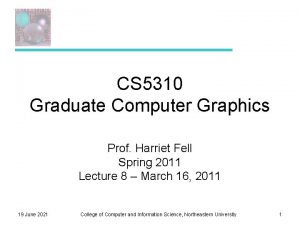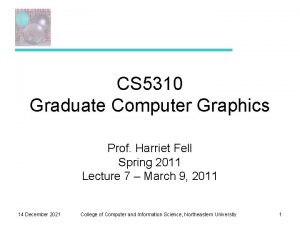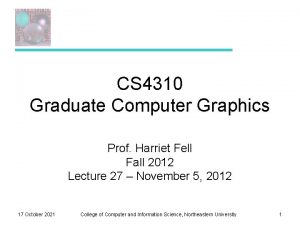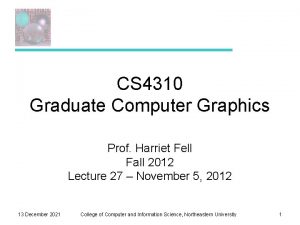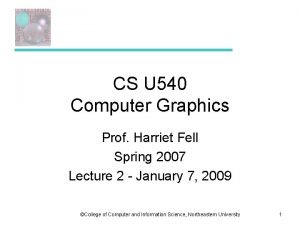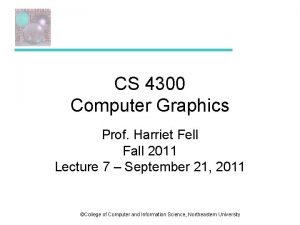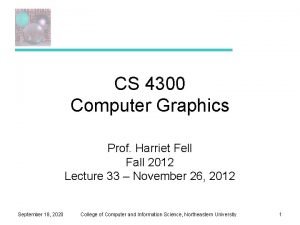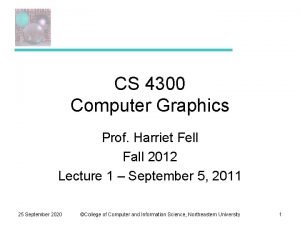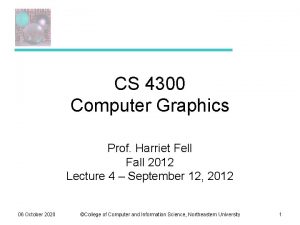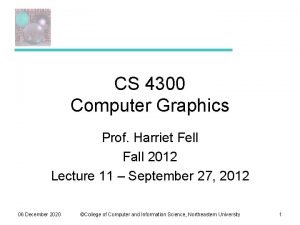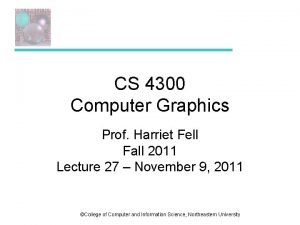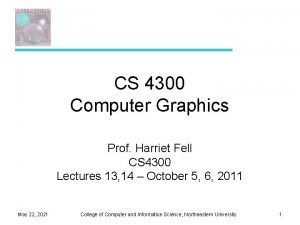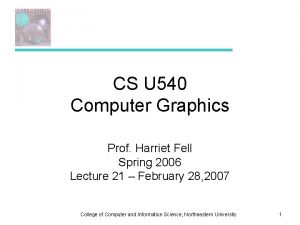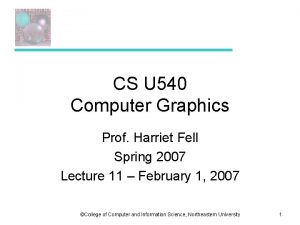CS 5310 Graduate Computer Graphics Prof Harriet Fell









































































- Slides: 73

CS 5310 Graduate Computer Graphics Prof. Harriet Fell Spring 2011 Lecture 1 – January 19, 2011 28 November 2020 ©College of Computer and Information Science, Northeastern University 1

Course Overview - Topics • Emphasis on rendering realistic images. • Fundamentals of 2 - and 3 - dimensional computer graphics – 2 -dimensional algorithms for drawing lines and curves, anti-aliasing, filling, and clipping – Using ray-tracing to render 3 -dimensional scenes • composed of spheres, polygons, quadric surfaces, and bicubic surfaces – Techniques for adding texture to surfaces using texture and bump maps, noise, and turbulence • Other topics as time permits 28 November 2020 ©College of Computer and Information Science, Northeastern University 2

Sample Images 28 November 2020 ©College of Computer and Information Science, Northeastern University 3

Sample Images 28 November 2020 ©College of Computer and Information Science, Northeastern University 4

Sample Images 28 November 2020 ©College of Computer and Information Science, Northeastern University 5

Sample Images 28 November 2020 ©College of Computer and Information Science, Northeastern University 6

Sample Images 28 November 2020 ©College of Computer and Information Science, Northeastern University 7

Course Overview - Organization • Texts: – Peter Shirley, et al. Fundamentals of Computer Graphics, 2 nd Edition, A K Peters, 2005 – Alan Watt, 3 D Computer Graphics, 3 rd Edition , Addison Wesley, 1999. • Grading – – – – Assignment 0: 10% Assignment 1: 15% Assignment 2: 15% Assignment 3: 10% Assignment 4: 10% Exam: 25% Project and Presentation: 15% 28 November 2020 ©College of Computer and Information Science, Northeastern University 8

Early History • • http: //accad. osu. edu/~waynec/history/timeline. html http: //sophia. javeriana. edu. co/~ochavarr/computer_graphics_history/historia/ • 1801 Joseph-Marie Jacquard invented an automatic loom using punched cards to control patterns in the fabrics. The introduction of these looms caused the riots against the replacement of people by machines. • 1941 First U. S. regular TV broadcast, 1 st TV commercial (for Bulova watches) • 1948 Transistors • 1949 Williams tube (CRT storage tube) 28 November 2020 ©College of Computer and Information Science, Northeastern University 9

Jacquard Loom From Wikipedia. org 28 November 2020 ©College of Computer and Information Science, Northeastern University 10

Early TV 28 November 2020 ©College of Computer and Information Science, Northeastern University 11

History – the 50 s • 1951 Graphics display, Whirlwind computer • 1954 color TV • 1955 Light Pen, SAGE- Lincoln Lab • 1958 Graphics Console, TX-1 MIT • 1958 John Whitney Sr. uses analog computer to make art 28 November 2020 ©College of Computer and Information Science, Northeastern University 12

1951 Graphics display, Whirlwind computer 28 November 2020 ©College of Computer and Information Science, Northeastern University 13

SAGE 28 November 2020 ©College of Computer and Information Science, Northeastern University 14

John Whitney Sr. 1958 CG Vertigo Start Titles 28 November 2020 ©College of Computer and Information Science, Northeastern University 15

History - the 60 s • 1961 Spacewars, 1 st video game, Steve Russell, MIT for PDP-1 • 1963 Sketchpad, Ivan Sutherland, MIT • 1963 Mouse invented, Doug Englebart, SRI • 1963 Roberts hidden line algorithm, MIT • 1965 Bresenham Algorithm for plotting lines, IBM • 1966 Odyssey, home video game, Ralph Baer, – Sanders Assoc, is 1 st consumer CG product • 1967 Full-color, real-time, interactive flight simulator for NASA - Rod Rougelet, GE 28 November 2020 ©College of Computer and Information Science, Northeastern University 16

Spacewars 28 November 2020 ©College of Computer and Information Science, Northeastern University 17

Ivan Sutherland & Sketchpad System on TX-2 at MIT(1963) 28 November 2020 ©College of Computer and Information Science, Northeastern University 18

Odyssey http: //gamesmuseum. pixesthesia. com/history/gen 1/pong/ 28 November 2020 ©College of Computer and Information Science, Northeastern University 19

Roberts Hidden Line Algorithm Block scene (576 blocks) 28 November 2020 ©College of Computer and Information Science, Northeastern University 20

Bresenham Line Algorithm (9, 7) (0, 0) 28 November 2020 ©College of Computer and Information Science, Northeastern University 21

History – the 70 s • • • 1970 s Utah dominated - algorithm development 1970 Watkins algorithm for visible surfaces 1970 Bezier free-form curve representation 1971 Gouraud shading 1973 Principles of Interactive Computer Graphics (Newman and Sproull) 1974 Addressable cursor in a graphics display terminal - DEC VT 52 1974 z-buffer developed by Ed Catmull (Univ of Utah) 1975 Phong shading 1975 Fractals - Benoit Mandelbrot (IBM) 1978 Bump mapping, Blinn 1979 George Lucas starts Lucasfilm – with Ed Catmull, Ralph Guggenheim, and Alvy Ray Smith 28 November 2020 ©College of Computer and Information Science, Northeastern University 22

Watkins Scan-Line Algorithm 28 November 2020 ©College of Computer and Information Science, Northeastern University 23

Bezier Curves 28 November 2020 ©College of Computer and Information Science, Northeastern University 24

Gouraud Shading http: //freespace. virgin. net/hugo. elias/graphics/x_polygo. htm 28 November 2020 ©College of Computer and Information Science, Northeastern University 25

Phong Shading 28 November 2020 ©College of Computer and Information Science, Northeastern University 26

Fractals 28 November 2020 ©College of Computer and Information Science, Northeastern University 27

Bump Maps in Pov. Ray 28 November 2020 ©College of Computer and Information Science, Northeastern University 28

History - the 80 s • • • 1980 s Cheaper machines, memory - quest for realsim 1980 Ray Tracing, Turner Whitted, Bell Labs 1981 IBM introduces the first IBM PC (16 bit 8088 chip) 1982 Data Glove, Atari 1984 Macintosh computer – introduced with Clio award winning commercial during Super Bowl • 1985 Perlin Noise • 1986 GIF format (Compu. Serve) • 1988 Who Framed Roger Rabbit live action & animation 28 November 2020 ©College of Computer and Information Science, Northeastern University 29

Whitted Ray-Tracing http: //en. wikipedia. org/wiki/Ray_tracing 28 November 2020 ©College of Computer and Information Science, Northeastern University 30

Perlin Noise 28 November 2020 ©College of Computer and Information Science, Northeastern University 31

Who Framed Roger Rabbit 28 November 2020 ©College of Computer and Information Science, Northeastern University 32

History- the 90 s • • 1990 s Visualization, Multimedia, the Net 1991 JPEG/MPEG 1993 Myst, Cyan 1994 U. S. Patent to Pixar – for creating, manipulating and displaying images • • • 1995 Toy Story, Pixar 1995 Internet 2 unveiled 1997 DVD technology unveiled 1998 XML standard 1999 deaths 28 November 2020 ©College of Computer and Information Science, Northeastern University 33

Myst 28 November 2020 ©College of Computer and Information Science, Northeastern University 34

Toy Story 28 November 2020 ©College of Computer and Information Science, Northeastern University 35

Recent History • 2000 s Virtual Reality, Animation Reality • 2001 Significant Movies – – – – Final Fantasy, Square) Monsters Inc, Pixar Harry Potter, A. I. , Lord of the Rings, Shrek, PDI The Mummy, ILM Tomb Raider, Cinesite Jurassic Park III, Pearl Harbor, ILM Planet of the Apes, Asylum • 2001 Microsoft x. Box and Nintendo Gamecube • 2001, 2002, 2003 Lord of the Rings – Gollum 28 November 2020 ©College of Computer and Information Science, Northeastern University 36

from Lord of the Rings • Motion Capture Technology – Andy Serkis "played" Gollum by providing his voice and movements on set, as well as performing within a motion capture suit. • SKIN – Christoper Hery, Ken Mc. Gaugh and Joe Letteri received a 2003 Academy Award, Scientific or Technical for implementing the BSSRDF (Bidirectional Surface Scattering Reflection Distribution Function) technique used for Gollum's skin in a production environment. Henrik Wann Jensen, Stephen Robert Marschner, and Pat Hanrahan, who developed BSSRDF, won another the same year. • MASSIVE – a computer program developed by WETA to create automatic battle sequences rather than individually animate every soldier. Stephen Regelous developed the system in 1996, originally to create crowd scenes in King Kong. 28 November 2020 ©College of Computer and Information Science, Northeastern University 37

Time for a Break 28 November 2020 ©College of Computer and Information Science, Northeastern University 38

Color www. thestagecrew. com 28 November 2020 ©College of Computer and Information Science, Northeastern University 39

Red, Green, and Blue Light 28 November 2020 ©College of Computer and Information Science, Northeastern University 40

Adding R, G, and B Values http: //en. wikipedia. org/wiki/RGB 28 November 2020 ©College of Computer and Information Science, Northeastern University 41

From the Hubble Site Link 28 November 2020 ©College of Computer and Information Science, Northeastern University 42

RGB Color Cube (0, 0, 1) (0, 1, 1) (1, 0, 1) (1, 1, 1) (1, 0, 0) (0, 1, 0) (1, 1, 0) 28 November 2020 ©College of Computer and Information Science, Northeastern University 43

RGB Color Cube The Dark Side (0, 0, 1) (0, 1, 1) (1, 0, 1) (0, 0, 0) (1, 0, 0) (0, 1, 0) (1, 1, 0) 28 November 2020 ©College of Computer and Information Science, Northeastern University 44

Doug Jacobson's RGB Hex Triplet Color Chart 28 November 2020 ©College of Computer and Information Science, Northeastern University 45

Making Colors Darker (1, 0, 0) (. 5, 0, 0) (0, 1, 0) (0, . 5, 0) (0, 0, 1) (0, 0, . 5) (0, 0, 0) (1, 1, 0) (0, . 5) (0, 0, 0) (1, 0, 1) (. 5, 0, . 5) (0, 0, 0) (1, 1, 0) (. 5, 0) (0, 0, 0) 28 November 2020 ©College of Computer and Information Science, Northeastern University 46

Getting Darker, Left to Right for (int b = 255; b >= 0; b--){ c = new Color(b, 0, 0); g. set. Paint(c); g. fill. Rect(800+3*(255 -b), 50, 3, 150); c = new Color(0, b, 0); g. set. Paint(c); g. fill. Rect(800+3*(255 -b), 200, 3, 150); c = new Color(0, 0, b); g. set. Paint(c); g. fill. Rect(800+3*(255 -b), 350, 3, 150); c = new Color(0, b, b); g. set. Paint(c); g. fill. Rect(800+3*(255 -b), 500, 3, 150); c = new Color(b, 0, b); g. set. Paint(c); g. fill. Rect(800+3*(255 -b), 650, 3, 150); c = new Color(b, b, 0); g. set. Paint(c); g. fill. Rect(800+3*(255 -b), 800, 3, 150); } 28 November 2020 ©College of Computer and Information Science, Northeastern University 47

Gamma Correction • Generally, the displayed intensity is not linear in the input (0 ≤ a ≤ 1). • disp. Intensity = (max. Intensity)aγ • To find γ – Find a that gives you. 5 intensity – Solve. 5 = aγ – Υ = ln(. 5) ln(a) 28 November 2020 ©College of Computer and Information Science, Northeastern University 48

Gamma Correction half black half red (127, 0, 0) • Gamma 28 November 2020 ©College of Computer and Information Science, Northeastern University 49

Making Pale Colors (1, 0, 0) (1, . 5) (1, 1, 1) (0, 1, 0) (. 5, 1, . 5) (1, 1, 1) (0, 0, 1) (. 5, 1) (1, 1, 0) (. 5, 1, 1) (1, 0, 1) (1, . 5, 1) (1, 1, 0) (1, 1, . 5) (1, 1, 1) 28 November 2020 ©College of Computer and Information Science, Northeastern University 50

Getting Paler, Left to Right for (int w = 0; w < 256; w++){ c = new Color(255, w, w); g. set. Paint(c); g. fill. Rect(3*w, 50, 3, 150); c = new Color(w, 255, w); g. set. Paint(c); g. fill. Rect(3*w, 200, 3, 150); c = new Color(w, w, 255); g. set. Paint(c); g. fill. Rect(3*w, 350, 3, 150); c = new Color(w, 255); g. set. Paint(c); g. fill. Rect(3*w, 500, 3, 150); c = new Color(255, w, 255); g. set. Paint(c); g. fill. Rect(3*w, 650, 3, 150); c = new Color(255, w); g. set. Paint(c); g. fill. Rect(3*w, 800, 3, 150); } 28 November 2020 ©College of Computer and Information Science, Northeastern University 51

Portable Pixmap Format (ppm) A "magic number" for identifying the file type. • A ppm file's magic number is the two characters "P 3". • Whitespace (blanks, TABs, CRs, LFs). • A width, formatted as ASCII characters in decimal. • Whitespace. • A height, again in ASCII decimal. • Whitespace. • The maximum color value again in ASCII decimal. • Whitespace. • Width * height pixels, each 3 values between 0 and maximum value. – – – start at top-left corner; proceed in normal English reading order three values for each pixel for red, green, and blue, resp. 0 means color is off; maximum value means color is maxxed out characters from "#" to end-of-line are ignored (comments) no line should be longer than 70 characters 28 November 2020 ©College of Computer and Information Science, Northeastern University 52

ppm Example P 3 # feep. ppm 4 4 15 0 0 0 15 0 0 0 0 15 7 0 0 0 15 0 0 0 28 November 2020 ©College of Computer and Information Science, Northeastern University 53

private void save. Image() { String out. File. Name = “my. ppm"; File out. File = new File(out. File. Name); int clr. R, clr. G, clr. B; try { Print. Writer out = new Print. Writer(new Buffered. Writer(new File. Writer(out. File))); out. println("P 3"); out. print(Integer. to. String(xmax-xmin+1)); System. out. println(xmax-xmin+1); out. print(" "); out. println(Integer. to. String(ymax-ymin+1)); System. out. println(ymax-ymin+1); out. println("255"); for (int y = ymin; y <= ymax; y++){ for (int x = xmin; x <= xmax; x++) { // compute clr. R, clr. G, clr. B out. print(" "); out. print(clr. R); out. print(" "); out. print(clr. G); out. print(" "); out. println(clr. B); } } out. close(); } catch (IOException e) { System. out. println(e. to. String()); } } 28 November 2020 ©College of Computer and Information Science, Northeastern University 54

Math Basics (All Readings from Shirley) • Sets and Mappings – 2. 1 • Quadratic Equations – 2. 2 • Trigonometry – 2. 3 • Vectors – 2. 4 • 2 D Parametric Curves – 2. 6 • 3 D Parametric Curves – 2. 8 • Linear Interpolation – 2. 10 • Triangles – 2. 11 28 November 2020 ©College of Computer and Information Science, Northeastern University 55

Vectors • A vector describes a length and a direction. a zero length vector a b 1 a unit vector a=b 28 November 2020 ©College of Computer and Information Science, Northeastern University 56

Vector Operations a b a a + b c d c-d b Vector Sum Vector Difference a 28 November 2020 -d -a ©College of Computer and Information Science, Northeastern University 57

Cartesian Coordinates • Any two non-zero, non-parallel 2 D vectors form a 2 D basis. • Any 2 D vector can be written uniquely as a linear combination of two 2 D basis vectors. • x and y (or i and j) denote unit vectors parallel to the x-axis and y-axis. • x and y form an orthonormal 2 D basis. a = xax + yay a =( xa, ya) or a =(ax, ay) • x, y and z form an orthonormal 3 D basis. 28 November 2020 ©College of Computer and Information Science, Northeastern University 58

Vector Length Vector a =( xa, ya ) | || a| a ya xa 28 November 2020 ©College of Computer and Information Science, Northeastern University 59

Dot Product a =( xa, ya ) b =( xb, yb ) a b = xa xb + ya yb a b = ||a|| � ||b||cos(φ) xa = ||a||cos(θ+φ) xb = ||b||cos(θ) ya = ||a||sin(θ+φ) a yb = ||b||sin(θ) φ θ 28 November 2020 b ©College of Computer and Information Science, Northeastern University 60

Projection a =( xa, ya ) b =( xb, yb ) a b = ||a|| ||b||cos(φ) The length of the projection of a onto b is given by 28 November 2020 a φ b a b ©College of Computer and Information Science, Northeastern University 61

3 D Vectors This all holds for 3 D vectors too. a =( xa, ya, za ) b =( xb, yb, zb ) a b = xa xb + ya yb + za zb a b = ||a|| ||b||cos(φ) 28 November 2020 ©College of Computer and Information Science, Northeastern University 62

Vector Cross Product axb is perpendicular to a and b. Use the right hand rule to determine the direction of axb. φ b a Image from www. physics. udel. edu 28 November 2020 ©College of Computer and Information Science, Northeastern University 63

Cross Product and Area axb b φ ||a|| a a ||a||x||b|| = area of the parallelogram. 28 November 2020 ©College of Computer and Information Science, Northeastern University 64

Computing the Cross Product 28 November 2020 ©College of Computer and Information Science, Northeastern University 65

Linear Interpolation • LERP: /lerp/, vi. , n. – Quasi-acronym for Linear Interpolation, used as a verb or noun for the operation. “Bresenham's algorithm lerps incrementally between the two endpoints of the line. ” p = (1 – t) a + t b = a + t(b – a) )L (1 -t t. L a 28 November 2020 b L ©College of Computer and Information Science, Northeastern University 66

Lerping p = (1 – t) a + t b = a + t(b – a) t=1 t=0 t =. 25 t =. 5 b t =. 75 L a 28 November 2020 ©College of Computer and Information Science, Northeastern University 67

Triangles a If (x, y) is on the edge ab, (x, y) = (1 – t) a + t b = a + t(b – a). Similar formulas hold for points on the other edges. (x, y) If (x, y) is in the triangle: (x, y) = α a + β b + γ c c b α + β + γ = 1 (α , β , γ ) are the Barycentric coordinates of (x, y). 28 November 2020 ©College of Computer and Information Science, Northeastern University 68

c-a β= c γ=0 b b-a γ = -1 α= 1 0 α= 28 November 2020 γ=2 γ=1 a Barycentric coordinates β= β= p = (1 - β - γ)a + βb + γc α = 1 - β - γ p = p(α, β, γ) = αa + βb + γc β= -1 0 p = a + β(b-a) + γ(c-a) 1 2 Triangles ©College of Computer and Information Science, Northeastern University 69

Computing Barycentric Coordinates a (x, y) b c 28 November 2020 ©College of Computer and Information Science, Northeastern University 70

Barycentric Coordinates as Areas a (x, y) c b 28 November 2020 where A is the area of the triangle. α + β + γ = 1 ©College of Computer and Information Science, Northeastern University 71

3 D Triangles a This all still works in 3 D. (x, y, z) c b 28 November 2020 where A is the area of the triangle. α + β + γ = 1 ©College of Computer and Information Science, Northeastern University 72

Assignment 0 • You will choose a programming platform for the quarter and familiarize yourself with RGB color and the ppm format. In part, this assignment is to ensure that you have a method of submitting you work so that I can: – read the code – compile (or interpret) the code – run the code to produce a file in ppm format. • Sample Program • You will write your own 3 D vector tools (e. g. as a JAVA class) that you will use for your later programming assignments. 28 November 2020 ©College of Computer and Information Science, Northeastern University 73
 Harriet fell
Harriet fell Harriet fell
Harriet fell Cp 5310
Cp 5310 Graphics monitor and workstation in computer graphics
Graphics monitor and workstation in computer graphics Computer graphics introduction ppt
Computer graphics introduction ppt Sensory figure of harriet
Sensory figure of harriet Underground railroad painting
Underground railroad painting Harriet tubman comic strip
Harriet tubman comic strip Harriet tubman
Harriet tubman Harriet beecher stowe biografia
Harriet beecher stowe biografia Frederick douglass and harriet jacobs
Frederick douglass and harriet jacobs Harriet shetler
Harriet shetler Harriet reich uchtdorf
Harriet reich uchtdorf Important dates for harriet tubman
Important dates for harriet tubman Harriet kung
Harriet kung Harriet tubman death
Harriet tubman death Education of harriet tubman
Education of harriet tubman Harriet westbrook
Harriet westbrook Harriet tubman
Harriet tubman Facts about harriet quimby
Facts about harriet quimby Aka graduate information session
Aka graduate information session Harriet hounsell
Harriet hounsell Harriet tubbmen
Harriet tubbmen Harriet tubman presentation
Harriet tubman presentation Bianaca lawson
Bianaca lawson Harriet powers bible quilt
Harriet powers bible quilt Harriet hemings
Harriet hemings Harriet whiley
Harriet whiley Uncle tom's cabin wikipedia
Uncle tom's cabin wikipedia Harriet quimby
Harriet quimby Our approach
Our approach Harriet jacobs husband
Harriet jacobs husband Harriet kung
Harriet kung Crt in computer graphics
Crt in computer graphics Types of projection in computer graphics
Types of projection in computer graphics Graphics display devices
Graphics display devices Interior and exterior clipping in computer graphics
Interior and exterior clipping in computer graphics Shear transformation in computer graphics
Shear transformation in computer graphics Glsl asin
Glsl asin Bressenham
Bressenham Computer graphics
Computer graphics Is the process of filling image or region.
Is the process of filling image or region. Advantages and disadvantages of scan line fill algorithm
Advantages and disadvantages of scan line fill algorithm Boundary fill algorithm
Boundary fill algorithm Raster scan display in computer graphics
Raster scan display in computer graphics Computer graphics
Computer graphics Lines in computer graphics
Lines in computer graphics Cs 418
Cs 418 Glcreatebuffer
Glcreatebuffer Depth sorting method in computer graphics
Depth sorting method in computer graphics Achromatic light in computer graphics
Achromatic light in computer graphics Interactive input
Interactive input Uniform scaling in computer graphics
Uniform scaling in computer graphics Uniform scaling in computer graphics
Uniform scaling in computer graphics Fundamentals of computer graphics
Fundamentals of computer graphics Logical input devices in computer graphics
Logical input devices in computer graphics Fundamentals of computer graphics
Fundamentals of computer graphics Points and lines in computer graphics ppt
Points and lines in computer graphics ppt Bresenham line drawing algorithm example ppt
Bresenham line drawing algorithm example ppt Line equation in computer graphics
Line equation in computer graphics Normalized device coordinate
Normalized device coordinate Keyframe animation in computer graphics
Keyframe animation in computer graphics Solid modeling in computer graphics
Solid modeling in computer graphics Scan conversion in computer graphics
Scan conversion in computer graphics Region filling and clipping in computer graphics
Region filling and clipping in computer graphics Utah teapot vertex data
Utah teapot vertex data Thick primitives in computer graphics
Thick primitives in computer graphics Interaction in computer graphics
Interaction in computer graphics Computer graphics
Computer graphics Computer graphics pipeline
Computer graphics pipeline Scan converting ellipse algorithm in computer graphics
Scan converting ellipse algorithm in computer graphics Srgp in computer graphics
Srgp in computer graphics Transformation computer graphics
Transformation computer graphics Dda circle drawing algorithm
Dda circle drawing algorithm
